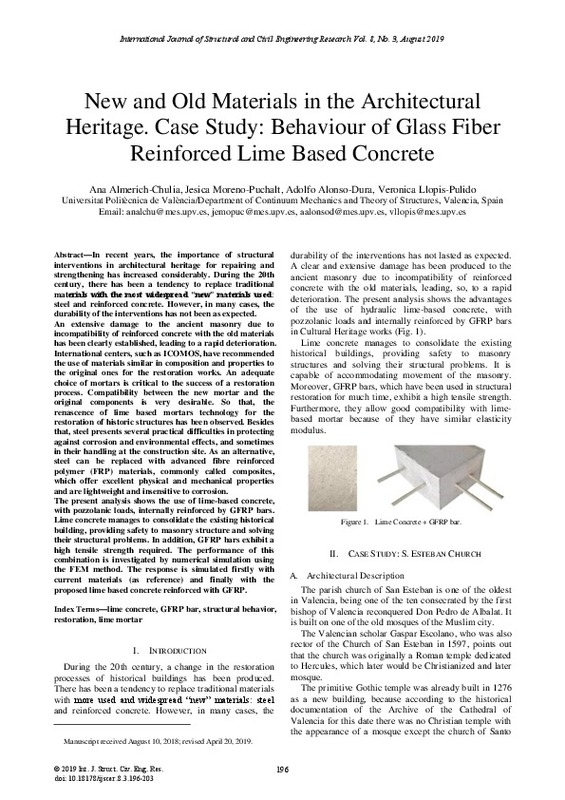JavaScript is disabled for your browser. Some features of this site may not work without it.
Buscar en RiuNet
Listar
Mi cuenta
Estadísticas
Ayuda RiuNet
Admin. UPV
New and Old Materials in the Architectural Heritage. Case Study: Behaviour of Glass Fiber Reinforced Lime Based Concrete
Mostrar el registro sencillo del ítem
Ficheros en el ítem
| dc.contributor.author | Almerich-Chulia, Ana
|
es_ES |
| dc.contributor.author | Moreno-Puchalt, Jesica
|
es_ES |
| dc.contributor.author | Alonso Durá, Adolfo
|
es_ES |
| dc.contributor.author | Llopis-Pulido, Veronica
|
es_ES |
| dc.date.accessioned | 2021-03-24T04:31:22Z | |
| dc.date.available | 2021-03-24T04:31:22Z | |
| dc.date.issued | 2019-08 | es_ES |
| dc.identifier.issn | 2319-6009 | es_ES |
| dc.identifier.uri | http://hdl.handle.net/10251/164160 | |
| dc.description.abstract | [EN] In recent years, the importance of structural interventions in architectural heritage for repairing and strengthening has increased considerably. During the 20th century, there has been a tendency to replace traditional materials with the most widespread ¿new¿ materials used: steel and reinforced concrete. However, in many cases, the durability of the interventions has not been as expected. An extensive damage to the ancient masonry due to incompatibility of reinforced concrete with the old materials has been clearly established, leading to a rapid deterioration. International centers, such as ICOMOS, have recommended the use of materials similar in composition and properties to the original ones for the restoration works. An adequate choice of mortars is critical to the success of a restoration process. Compatibility between the new mortar and the original components is very desirable. So that, the renascence of lime based mortars technology for the restoration of historic structures has been observed. Besides that, steel presents several practical difficulties in protecting against corrosion and environmental effects, and sometimes in their handling at the construction site. As an alternative, steel can be replaced with advanced fibre reinforced polymer (FRP) materials, commonly called composites, which offer excellent physical and mechanical properties and are lightweight and insensitive to corrosion. The present analysis shows the use of lime-based concrete, with pozzolanic loads, internally reinforced by GFRP bars. Lime concrete manages to consolidate the existing historical building, providing safety to masonry structure and solving their structural problems. In addition, GFRP bars exhibit a high tensile strength required. The performance of this combination is investigated by numerical simulation using the FEM method. The response is simulated firstly with current materials (as reference) and finally with the proposed lime based concrete reinforced with GFRP. | es_ES |
| dc.language | Inglés | es_ES |
| dc.publisher | EJournal Publishing | es_ES |
| dc.relation.ispartof | International Journal of Structural and Civil Engineering Research | es_ES |
| dc.rights | Reserva de todos los derechos | es_ES |
| dc.subject | Lime concrete | es_ES |
| dc.subject | GFRP bar | es_ES |
| dc.subject | Structural behavior | es_ES |
| dc.subject | Restoration | es_ES |
| dc.subject | Lime mortar | es_ES |
| dc.subject.classification | MECANICA DE LOS MEDIOS CONTINUOS Y TEORIA DE ESTRUCTURAS | es_ES |
| dc.title | New and Old Materials in the Architectural Heritage. Case Study: Behaviour of Glass Fiber Reinforced Lime Based Concrete | es_ES |
| dc.type | Artículo | es_ES |
| dc.identifier.doi | 10.18178/ijscer.8.3.196-203 | es_ES |
| dc.rights.accessRights | Abierto | es_ES |
| dc.contributor.affiliation | Universitat Politècnica de València. Departamento de Mecánica de los Medios Continuos y Teoría de Estructuras - Departament de Mecànica dels Medis Continus i Teoria d'Estructures | es_ES |
| dc.description.bibliographicCitation | Almerich-Chulia, A.; Moreno-Puchalt, J.; Alonso Durá, A.; Llopis-Pulido, V. (2019). New and Old Materials in the Architectural Heritage. Case Study: Behaviour of Glass Fiber Reinforced Lime Based Concrete. International Journal of Structural and Civil Engineering Research. 8(3):196-203. https://doi.org/10.18178/ijscer.8.3.196-203 | es_ES |
| dc.description.accrualMethod | S | es_ES |
| dc.relation.publisherversion | https://doi.org/10.18178/ijscer.8.3.196-203 | es_ES |
| dc.description.upvformatpinicio | 196 | es_ES |
| dc.description.upvformatpfin | 203 | es_ES |
| dc.type.version | info:eu-repo/semantics/publishedVersion | es_ES |
| dc.description.volume | 8 | es_ES |
| dc.description.issue | 3 | es_ES |
| dc.relation.pasarela | S\392263 | es_ES |








